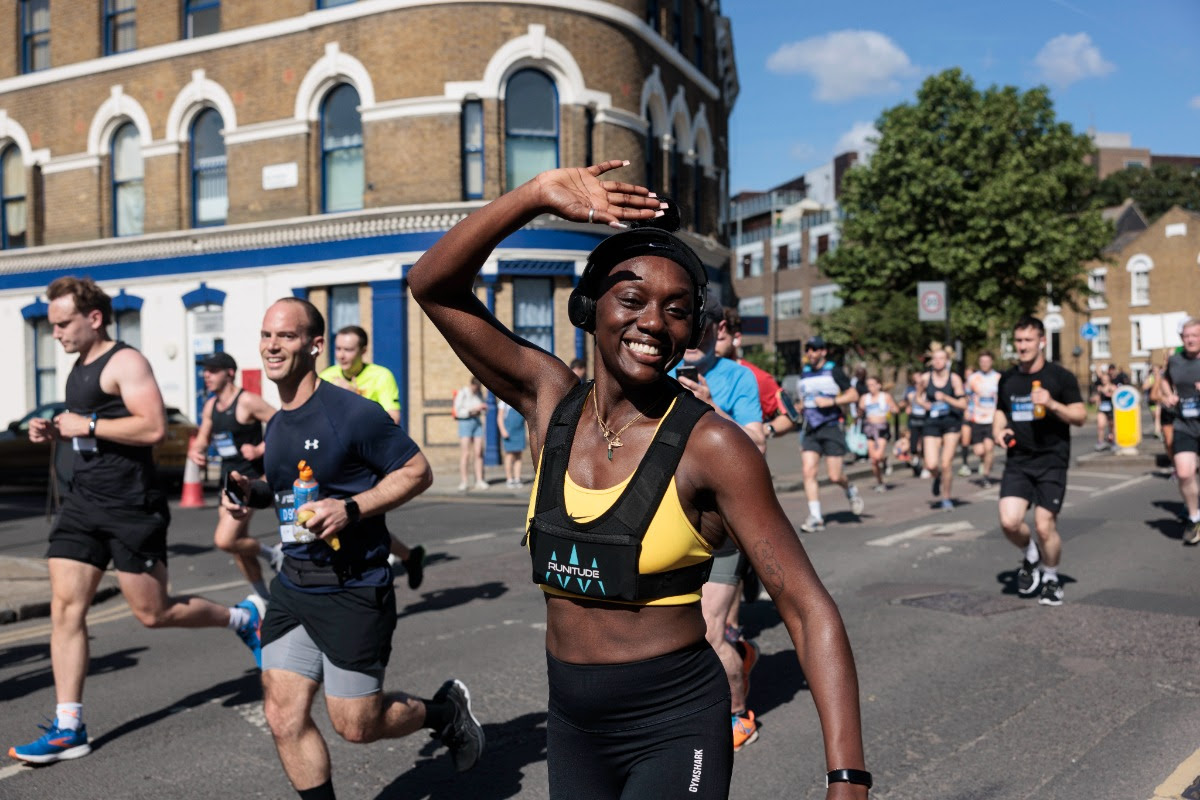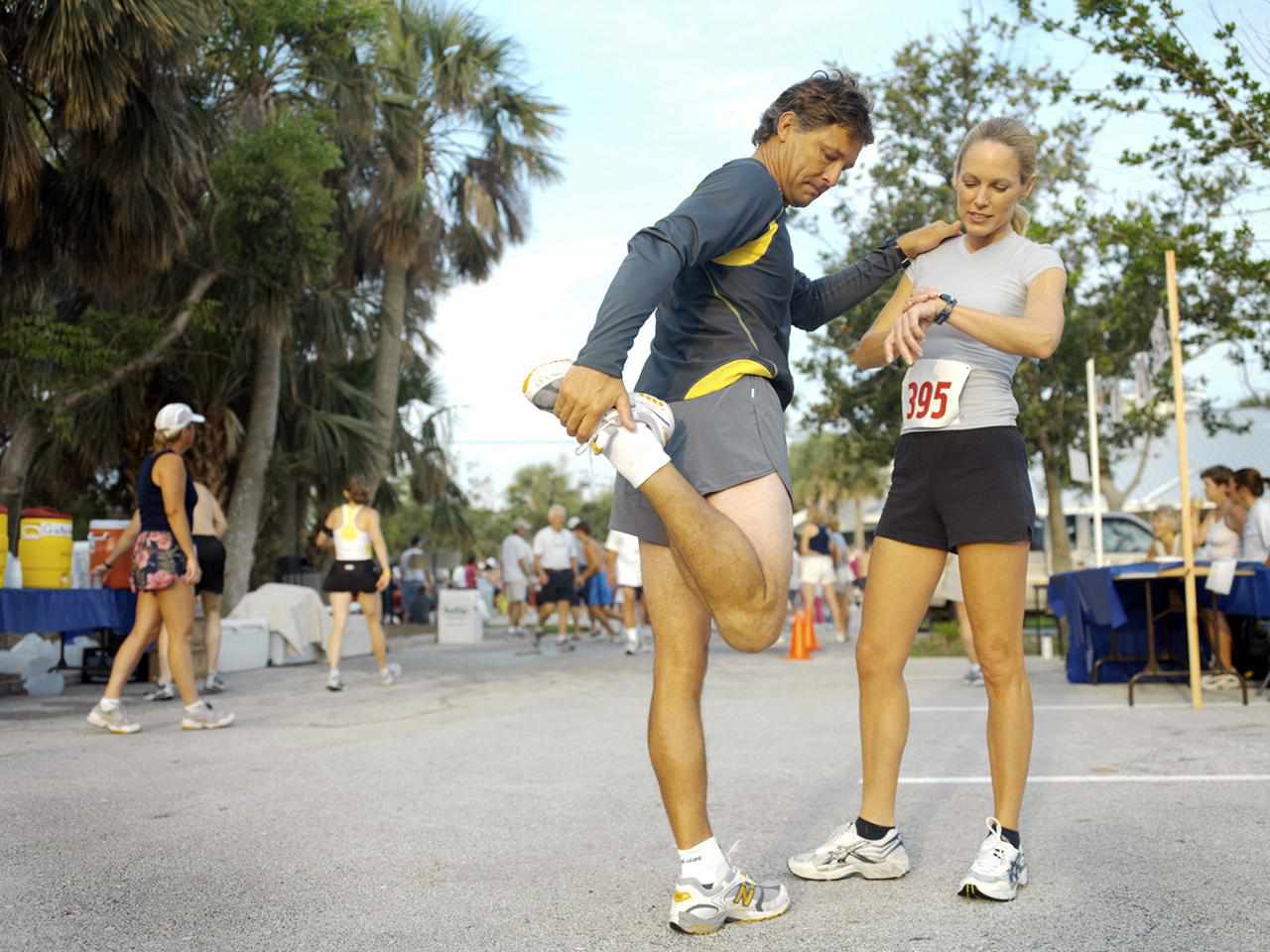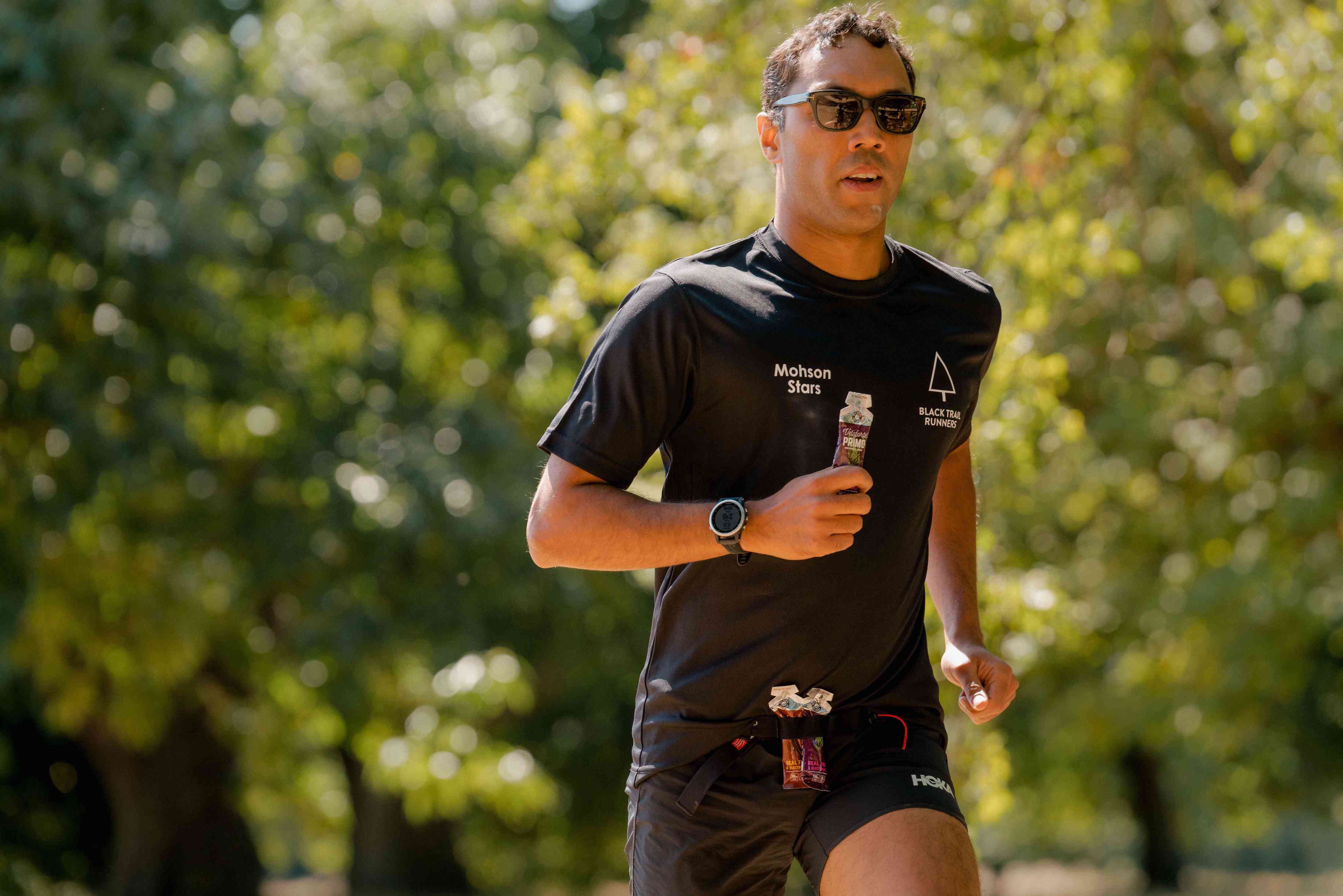

Featured
How To Run Half Marathon Faster
Modified: August 21, 2023
Discover the top tips and strategies to improve your speed and performance in half marathons. Join our featured training program and achieve your running goals faster.
Introduction
Running a half marathon is an incredible accomplishment, but what if you want to take your performance to the next level? If you’re looking to improve your half marathon time and run faster, you’ve come to the right place. In this article, we’ll explore proven strategies and techniques that will help you speed up your half marathon pace and achieve your goals.
Running a faster half marathon requires a combination of proper training, dedication, and a focused mindset. It’s not just about running more miles, but also about incorporating specific workouts, building endurance, and adopting efficient running form. With the right approach and consistent effort, you can shave minutes off your personal best and enjoy a more satisfying race experience.
Whether you’re a beginner looking to complete your first half marathon or a seasoned runner aiming for a new personal record, this article will provide you with the necessary guidance to improve your speed and performance. You’ll learn how to set realistic goals, create a training schedule, incorporate speed workouts, build endurance, cross-train effectively, fuel your body with proper nutrition, prevent injuries, and develop mental strategies for race day.
It’s important to note that everyone’s journey to faster half marathon times is unique. What works for one person may not work for another, and it’s essential to listen to your body throughout the training process. With that said, the tips and techniques shared in this article have been proven successful by many runners and can serve as a valuable starting point on your quest for faster half marathon times.
So, if you’re ready to push your limits, challenge yourself, and reach new levels of performance, let’s dive into the world of half marathon training and discover the strategies that will help you run faster and achieve your goals.
Importance of Half Marathon Training
Training for a half marathon is not only essential for completing the race but also for running it faster. Proper training lays the foundation for improved speed, endurance, and overall performance. Here are some key reasons why half marathon training is crucial:
- Builds Endurance: Half marathon training gradually increases your running distance, allowing your body to adapt and build endurance. By consistently challenging yourself with longer runs, you’ll develop the stamina needed to sustain a faster pace throughout the race.
- Improves Speed: Training for a half marathon involves incorporating specific speed workouts, such as interval training and tempo runs. These workouts help improve your cardiovascular fitness, increase your lactate threshold, and enhance your running efficiency, resulting in faster race times.
- Prevents Injuries: Half marathon training involves a gradual increase in mileage and incorporates rest days for recovery. This structured approach reduces the risk of overuse injuries and gives your body time to repair and strengthen itself. It’s important to listen to your body and avoid overtraining, as pushing too hard can lead to injuries that may hinder your progress.
- Boosts Confidence: Training for a half marathon is challenging, and as you progress and see improvements in your running ability, your confidence will soar. The sense of accomplishment and the knowledge that you’ve put in the hard work and dedication required to become faster will give you a mental edge on race day.
- Mental Toughness: Half marathon training requires discipline and mental toughness. The long runs, challenging workouts, and occasional setbacks during training will test your determination and resilience. By overcoming these obstacles and pushing through mental barriers, you’ll develop a strong mindset that will help you push through any challenges you encounter during the race.
Remember, half marathon training is not just about the physical aspect; it’s also about mental preparation. The training process teaches you to stay focused, persevere, and stay motivated when the going gets tough. It’s not just running; it’s a journey of self-discovery and personal growth.
So, embrace the importance of half marathon training and commit yourself to the process. Not only will you become a faster and stronger runner, but you’ll also gain a sense of accomplishment and satisfaction that comes from achieving your goals. Lace up your running shoes, set realistic targets, and let the training begin.
Setting Goals for Faster Half Marathon
Setting clear and realistic goals is paramount when training for a faster half marathon. Having a specific target in mind gives you focus, motivation, and a sense of purpose throughout your training journey. Here are some key steps to help you set effective goals:
- Define Your Objective: Start by determining what you want to achieve in your half marathon. Is it a new personal best? A specific finishing time? Or perhaps completing the race without stopping? Having a clear objective will guide your training and help you stay on track.
- Consider Your Current Abilities: Assess your current fitness level, running experience, and previous race performances. Be honest with yourself about your strengths and areas for improvement. This self-awareness will help you set realistic and achievable goals that take into account your current abilities.
- Set SMART Goals: SMART stands for Specific, Measurable, Attainable, Relevant, and Time-bound. Your goals should be specific, clearly outlining what you want to achieve. They should also be measurable, allowing you to track your progress along the way. Ensure that your goals are attainable and relevant to your running abilities and aspirations. Lastly, set a target deadline for when you want to achieve your goals.
- Break Down Your Goals: Breaking your main goal into smaller, manageable milestones can make it less overwhelming and more achievable. For example, if your goal is to finish the half marathon in under two hours, you can set milestones for improving your pace by 30 seconds per mile or completing certain weekly mileage targets.
- Track Your Progress: Tracking your training progress is crucial for staying motivated and adjusting your training if needed. Use a running app or a training log to keep a record of your mileage, pace, and workouts. Regularly reviewing your progress will help you stay accountable and make necessary adjustments to ensure you’re on track to reach your goals.
- Be Flexible: While setting goals is important, it’s crucial to remain flexible and open to adjustments. Factors such as injuries, weather conditions, and life commitments may impact your training plan. Be willing to adapt and modify your goals as necessary while keeping your eye on the overarching objective.
Setting goals for a faster half marathon will not only provide you with a clear focus but also serve as a source of motivation throughout your training. Remember that achieving your goals requires consistent effort, patience, and an unwavering belief in your abilities. So, set your targets, break them down, and embark on your journey to a faster half marathon with determination and passion.
Creating a Training Schedule
A well-structured training schedule is essential for improving your half marathon time and running faster. It provides a roadmap for your training, ensuring that you gradually build mileage, incorporate different types of workouts, and allow for adequate recovery. Here are some key steps to create an effective training schedule:
- Assess Your Availability: Start by realistically assessing the time you can commit to training each week. Consider your work schedule, family commitments, and other obligations. This will help you determine the number of training days per week and the duration of each workout.
- Set a Race Date: Select a specific race date or choose a target event you wish to participate in. Having a race date in mind will give you a timeline and help structure your training schedule accordingly.
- Build Base Mileage: Begin your training schedule with a focus on gradually building your base mileage. This means increasing your total weekly mileage at a steady and manageable pace. Start with a comfortable distance and increase it by no more than 10% each week to minimize the risk of injury.
- Incorporate Different Types of Runs: A well-rounded training schedule includes a mix of long runs, tempo runs, interval training, and easy recovery runs. Long runs develop endurance, tempo runs teach you to sustain a faster pace, interval training improves speed, and easy runs aid in recovery.
- Include Rest Days: Rest days are just as important as training days. They allow your body to recover, rebuild, and prevent overuse injuries. Be sure to include at least one or two rest days per week in your training schedule.
- Consider Cross-Training: Incorporating cross-training activities such as swimming, cycling, or strength training can help improve overall fitness, prevent muscle imbalances, and provide variety to your training schedule. Aim for one or two cross-training sessions per week, alternating them with running days.
- Gradually Increase Intensity: As you progress through your training schedule, gradually increase the intensity of your workouts. This can include adding more speed intervals, increasing the pace during tempo runs, or tackling more challenging hill workouts. Progressing gradually helps prevent burnout and minimizes the risk of injury.
- Adapt and Adjust: Be flexible with your training schedule. It’s essential to listen to your body and make adjustments when necessary. If you’re feeling excessively fatigued or experiencing pain, don’t hesitate to modify your schedule or take an extra rest day. Prioritize recovery to avoid overtraining and injury.
- Monitor Your Progress: Keep track of your training progress using a running app or training log. This will help you stay accountable, track your mileage and pace, and identify areas of improvement. Regularly assess and adjust your training schedule based on your progress and individual needs.
Creating a well-balanced training schedule is key to developing the necessary skills, endurance, and speed required to run a faster half marathon. Remember to be consistent, listen to your body, and be adaptable as you progress through your training. With a solid training schedule, dedication, and a positive mindset, you’re well on your way to achieving your goal of running a faster half marathon.
Incorporating Speed Workouts
To improve your speed and run a faster half marathon, incorporating speed workouts into your training routine is crucial. These workouts are designed to challenge your cardiovascular system, improve your running economy, and increase your lactate threshold. Here are some key tips for incorporating speed workouts into your training:
- Interval Training: Interval training involves alternating between periods of high-intensity running and periods of active recovery. For example, you could run at a fast pace for 400 meters, followed by a slow jog or walk for 200 meters. Repeat this cycle for a specific number of repetitions, gradually increasing the number as your fitness improves. Interval training improves your anaerobic capacity and helps you sustain a faster pace.
- Tempo Runs: Tempo runs are sustained efforts at a pace slightly faster than your goal half marathon pace. These runs are typically between 20-40 minutes in duration. Tempo runs help improve your lactate threshold, which is the point at which lactic acid begins to accumulate in your muscles. By running at this threshold, you teach your body to clear lactic acid more efficiently, allowing you to maintain a faster pace for longer periods.
- Hill Repeats: Hill repeats are an excellent way to build leg strength, improve running form, and increase overall power. Find a hill with a moderate incline and sprint up it for a specific distance, focusing on maintaining good running mechanics. Jog or walk back down for recovery, then repeat the uphill sprint for a set number of repetitions. Hill repeats not only improve your speed on inclines but also help you maintain a strong and efficient running form on flat terrain.
- Fartlek Training: Fartlek, which means “speed play” in Swedish, involves alternating between periods of easy running and bursts of faster running. During a run, spontaneously pick up the pace for a short distance, such as from one lamppost to the next, then return to your regular pace. Fartlek training helps improve your ability to change pace and adapt to varying conditions, simulating race scenarios and improving your overall speed.
- Track Workouts: If you have access to a track, it’s an ideal location for speed workouts. You can incorporate exercises like 400-meter repeats, where you run one lap around the track at a challenging pace, followed by a recovery jog or walk. Tackling shorter distances such as 200 meters or 800 meters can also help improve your speed and anaerobic capacity.
- Progression Runs: Progression runs involve starting your run at a comfortable pace and gradually increasing your speed as you progress. For example, you can start with an easy warm-up pace for the first few miles, then gradually pick up the pace to a faster effort for the remaining miles. This helps teach your body to maintain a consistent effort and finish strong amidst fatigue.
When incorporating speed workouts into your training, remember to warm up properly with a dynamic routine and cool down with some gentle stretches. Don’t push yourself too hard too soon; progress gradually and listen to your body. It’s essential to find the right balance between pushing your limits and avoiding overexertion.
Incorporating speed workouts once or twice a week in your training schedule will help improve your running economy, increase your body’s ability to handle higher intensities, and ultimately make you a faster half marathon runner.
Building Endurance and Stamina
Building endurance and stamina is crucial for running a faster half marathon. These attributes help you maintain a consistent pace throughout the race and have the energy to finish strong. Here are some key strategies to enhance your endurance and stamina:
- Long Runs: Incorporate long runs into your training schedule to build endurance gradually. Start with a distance that challenges you but is manageable, and gradually increase the duration or distance each week. Long runs teach your body to handle the demands of running for an extended period, improving your ability to maintain a steady pace during the half marathon.
- Tempo Runs: Tempo runs not only improve your speed but also increase your lactate threshold, which is crucial for maintaining a strong pace. These runs require sustaining a comfortably hard effort just below your anaerobic threshold. By regularly incorporating tempo runs into your training, you’ll increase your ability to run at a faster pace for a longer duration.
- Progressive Overload: Gradually increase the demands of your training by progressively overloading your body. This can be done by adding mileage or duration to your runs, picking up the pace during intervals or tempo runs, or incorporating more challenging terrain. This gradual increase in workload stimulates adaptations in your cardiovascular system, helping you improve your endurance and stamina.
- Split Runs: Split runs involve dividing your daily mileage into two shorter runs, typically performed in the morning and evening. This method allows you to accumulate more mileage in a single day without overtaxing your body. Split runs are especially beneficial for increasing your weekly mileage and teaching your body to handle running on tired legs.
- Cross-Training: Supplement your running with cross-training activities such as swimming, cycling, or strength training. These alternative exercises help improve overall cardiovascular fitness, build strength in different muscle groups, and provide active recovery. Cross-training can enhance your endurance and stamina while reducing the risk of overuse injuries associated with high-volume running.
- Progression Runs: Incorporate progression runs into your training schedule to develop your ability to maintain a consistent effort and finish strong. Start your run at an easy pace, gradually increase the intensity as you progress, and finish at a hard effort. This mimics the demands of the later stages of a half marathon, helping you mentally and physically prepare for a strong finish.
- Rest and Recovery: Rest and recovery are vital for building endurance and stamina. Your body needs time to repair, rebuild, and adapt to the demands of training. Include rest days in your weekly schedule and prioritize quality sleep. Additionally, incorporate active recovery days, where you engage in low-intensity exercise or activities like yoga or foam rolling to promote blood flow and prevent muscle tightness.
Building endurance and stamina takes time and consistent effort. It’s important to listen to your body, gradually progress your training, and be patient with the process. By incorporating these strategies into your training regimen, you’ll develop the endurance and stamina necessary to run a faster and more enjoyable half marathon.
Cross Training for Half Marathon
Cross training is an essential component of half marathon training as it helps to improve overall fitness, prevent injuries, and enhance your performance. It involves engaging in alternative exercises and activities that complement your running regimen. Here are some key benefits and strategies for incorporating cross training into your half marathon training:
- Improved Cardiovascular Fitness: Cross training activities such as swimming, cycling, or rowing provide an excellent way to improve cardiovascular fitness. These low-impact exercises give your joints a break from the repetitive impact of running while still enhancing your heart and lung capacity.
- Injury Prevention: Running continuously can lead to overuse injuries. Incorporating cross training activities that target different muscle groups can help prevent imbalances and reduce the risk of injury. Exercises such as strength training, yoga, or Pilates can improve muscular strength, flexibility, and stability, keeping you strong and resilient throughout your half marathon training.
- Variety and Motivation: Cross training adds variety to your training routine, making it more enjoyable and reducing the risk of burnout. Trying new activities engages different muscles and challenges your body in different ways, keeping your workouts interesting and maintaining your motivation throughout your training.
- Active Recovery: Cross training can serve as an active recovery tool on rest days or during light training periods. Engaging in low-impact activities like swimming or cycling promotes blood flow, aids in muscle recovery, and reduces soreness. Active recovery helps maintain fitness and prepares your body for more intense training sessions.
- Specificity Training: Choose cross training activities that mimic the movements and demands of running to enhance your performance. For example, using an elliptical machine or stair climber can simulate the leg movements of running while reducing the impact on your joints. This specificity training helps improve your cardiovascular fitness and running economy.
- Strategic Scheduling: Determine the optimal timing for your cross training sessions. For example, consider alternating days of running with days of cross training to give your muscles time to recover. You can also use cross training activities as warm-up or cool-down exercises before or after your running workouts.
- Consistency and Balance: Aim for consistency in your cross training routine. Schedule regular sessions throughout your training plan to experience the most benefits. However, it’s essential to strike a balance between your running and cross training activities. Ensure that your cross training doesn’t interfere with your primary goal of running a faster half marathon but rather complements and supports it.
When incorporating cross training into your half marathon training, consider your individual preferences, fitness level, and time availability. Experiment with different activities to find what works best for you. Remember to listen to your body and avoid overtraining, as excessive cross training can lead to fatigue or hinder your running progress.
Incorporating cross training activities into your half marathon training will not only improve your overall fitness but also enhance your running performance and reduce the risk of injury. So, embrace the benefits of cross training and diversify your training routine to become a stronger, more well-rounded runner.
Tips for Improving Running Form
Having good running form is essential for maximizing your efficiency, preventing injuries, and running faster. While individual running styles may vary, there are some general tips to improve your running form. Here are some key tips to help you fine-tune your technique:
- Maintain an upright posture: Keep your head up, shoulders relaxed, and torso tall. Avoid leaning forward or slouching, as this can disrupt your alignment and impede your breathing.
- Engage your core: Activate your core muscles by pulling your belly button towards your spine. This will help stabilize your torso and maintain proper alignment throughout your run.
- Relax your hands and arms: Keep your hands relaxed and unclenched, with a slight bend at the elbow. Allow your arms to swing naturally and avoid crossing them over your body. This will help maintain balance and conserve energy.
- Land midfoot: Aim to strike the ground with your midfoot, rather than your heel or forefoot. This promotes a more efficient running stride and reduces the risk of excessive impact and injuries.
- Increase cadence: Strive for a quick turnover by increasing your running cadence. Aim for a cadence of around 170-180 steps per minute. This helps minimize ground contact time and improves running efficiency.
- Focus on short, light steps: Avoid overstriding by taking short, light steps. This helps maintain a quicker cadence and reduces the impact on your lower body. Land underneath your body’s center of gravity to optimize efficiency.
- Stride with purpose: Push off the ground with force and drive your knee forward. This action will help propel you forward and generate power in your stride.
- Breathe deeply and rhythmically: Practice diaphragmatic breathing, inhaling deeply through your nose and exhaling fully through your mouth. Find a breathing pattern that feels comfortable and matches your running rhythm.
- Listen to your body: Pay attention to any discomfort or pain while running. If you experience any unusual sensations or symptoms, assess your form and make adjustments as necessary. If needed, consult a running professional or coach for a more in-depth analysis of your running mechanics.
- Gradually incorporate drills and exercises: Incorporate specific drills and exercises into your training routine to improve your running form. These may include high knees, butt kicks, and plyometrics to strengthen key running muscles and reinforce proper mechanics.
Improving your running form takes time, practice, and mindful effort. It’s important to focus on one aspect at a time and gradually integrate changes into your running routine. Recording yourself running and seeking feedback from a running coach or experienced runner can also provide valuable insights into areas for improvement.
Remember that running form is a highly individualized aspect of running. While certain principles apply broadly, it’s crucial to find a form that feels natural and comfortable for you. Focus on making steady progress and maintaining consistency, and over time, you’ll develop a more efficient and fluid running form that will help you run faster and with reduced risk of injury.
Proper Nutrition for Half Marathon Training
Proper nutrition plays a vital role in supporting your half marathon training and optimizing your performance. Fueling your body with the right nutrients before, during, and after your runs can enhance your energy levels, aid in recovery, and ensure that you have the necessary stamina to run a faster half marathon. Here are some key nutrition tips to keep in mind during your training:
- Balance macro and micronutrients: Eat a well-balanced diet that includes a mix of carbohydrates, protein, and healthy fats. Carbohydrates provide the primary source of fuel for endurance activities, while protein helps repair and build muscles. Healthy fats support hormone production and aid in nutrient absorption.
- Carbohydrates for energy: During your half marathon training, focus on consuming complex carbohydrates such as whole grains, fruits, vegetables, and legumes. These provide sustained energy, steady blood sugar levels, and crucial vitamins and minerals.
- Pre-run fuel: It’s essential to eat a small, balanced meal or snack 1-2 hours before your run to top up your glycogen stores. Opt for easily digestible carbohydrates paired with a small amount of protein. Examples include a banana with nut butter or oatmeal with berries and yogurt.
- Hydration: Proper hydration is key for optimal performance. Aim to drink water regularly throughout the day and ensure you’re adequately hydrated before, during, and after your runs. Sports drinks or electrolyte solutions may be beneficial during longer runs to replace electrolytes lost through sweat.
- During-run fuel: For longer runs, you may need to consume additional carbohydrates to maintain energy levels. Experiment with different fueling options such as energy gels, sports drinks, or chews to find what works best for you. Practice with these fueling methods during your training runs to avoid any gastrointestinal issues on race day.
- Post-run recovery: Refuel your body within 30-60 minutes of completing a run. This window is crucial for replenishing glycogen stores and promoting muscle recovery. Choose a snack or meal that combines carbohydrates and protein, such as a smoothie with added protein powder or a peanut butter and jelly sandwich.
- Intuitive eating: Listen to your body’s hunger and fullness cues. Eat when you’re hungry and stop when you’re comfortably full. Pay attention to the quality and quantity of food you consume, ensuring your choices align with your training goals.
- Vitamins and minerals: Focus on a diet rich in fruits, vegetables, and whole foods to provide a wide range of vitamins and minerals. These nutrients are essential for immune function, energy production, and overall health.
- Consider professional advice: If you have specific dietary restrictions, allergies, or medical conditions, consider working with a registered dietitian who specializes in sports nutrition. They can provide personalized guidance to meet your nutritional needs during training.
Remember that nutrition is a highly individual aspect of training, and what works for one person may not work for another. It’s essential to experiment with different strategies during your training runs to find the approach that works best for you. Additionally, practice your nutrition plan during your long training runs to ensure it’s effective and easily implemented on race day.
By fueling your body with the right nutrients, staying properly hydrated, and listening to your body’s needs, you can optimize your half marathon training and set yourself up for success on race day.
Recovery and Injury Prevention
Recovery and injury prevention are crucial aspects of half marathon training. Taking care of your body during and after your runs helps prevent injuries, promotes proper muscle repair, and ensures your long-term success as a runner. Here are some key strategies to prioritize recovery and prevent injuries:
- Proper Warm-up and Cool-down: Begin each run with a dynamic warm-up routine to prepare your muscles, joints, and cardiovascular system for the upcoming workout. Incorporate mobility exercises, leg swings, and light jogging to increase blood flow and loosen up your muscles. After your run, cool down with a few minutes of easy jogging and gentle stretching to promote muscle recovery.
- Rest and Active Recovery: Allow your body adequate rest days in your training schedule. Rest days give your muscles time to repair and adapt to the training stress. On rest days, engage in low-impact activities like swimming, cycling, or yoga to promote blood flow, aid in muscle recovery, and reduce muscle soreness.
- Listen to Your Body: Pay attention to any signs of fatigue, pain, or discomfort during your runs. Pushing through excessive fatigue or pain can lead to overuse injuries. If something feels off, scale back your intensity or mileage, or take an extra rest day. It’s better to be cautious and prevent injuries than to risk setback and prolong your training.
- Cross-Training: Incorporate cross-training activities such as swimming, cycling, or strength training into your training routine. These activities engage different muscle groups, provide variety, and help prevent overuse injuries. Cross-training also improves overall fitness and complements your running efforts.
- Strength Training: Include strength training exercises that target key running muscles such as the glutes, core, and legs. Strengthening these muscles improves running form, enhances stability, and reduces the risk of injuries. Focus on exercises like squats, lunges, bridges, and planks.
- Proper Nutrition: Fueling your body with a well-balanced diet supports muscle recovery and overall health. Include adequate protein to repair and rebuild muscles, and consume nutrient-dense whole foods to provide essential vitamins and minerals. Also, prioritize hydration, both during and after your runs, to maintain proper fluid balance and aid in recovery.
- Stretching and Flexibility: Incorporate regular stretching and flexibility exercises to improve joint mobility, muscle elasticity, and overall range of motion. Static stretches, dynamic stretches, and foam rolling can help reduce muscle tightness, prevent imbalances, and improve your running mechanics.
- Gradual Progression: Gradually increase your training volume and intensity to allow your body to adapt. Sudden increases in mileage or intensity can lead to overuse injuries. Follow the 10% rule, which suggests increasing your mileage by no more than 10% per week, to minimize the risk of overtraining.
- Quality Sleep: Prioritize quality sleep as it is essential for both physical and mental recovery. Aim for 7-9 hours of uninterrupted sleep each night to optimize muscle repair, hormone regulation, and overall performance.
- Listen to Professionals: If you experience persistent pain or suspect an injury, seek advice from a healthcare professional or sports medicine specialist. They can provide a diagnosis, recommend appropriate treatment, and offer guidance on modifications to your training to support healing and prevent further injuries.
Remember, prevention is key when it comes to injuries. Prioritize recovery, listen to your body, and take a proactive approach to injury prevention to enjoy a successful and injury-free half marathon training journey.
Mental Strategies for Running Faster Half Marathon
Running a faster half marathon isn’t just about physical strength and endurance; it also requires mental fortitude and focus. Training your mind is as important as training your body when it comes to achieving your goal. Here are some key mental strategies to help you run a faster half marathon:
- Set Clear and Realistic Goals: Define your goals for the race and break them down into smaller, achievable milestones. Having a clear objective gives you something to work towards and helps you stay motivated throughout your training.
- Visualize Success: Use visualization techniques to imagine yourself running the half marathon with ease and achieving your desired time. Visualize the course, visualize yourself overcoming obstacles, and crossing the finish line with a strong, confident stride.
- Positive Self-Talk: Replace negative self-talk with positive affirmations. Use encouraging phrases like “I am strong,” “I am capable,” and “I can do this” to boost your confidence and keep your mindset positive during training and on race day.
- Stay Present: Focus on the present moment during your runs rather than worrying about the distance ahead or dwelling on past performances. Pay attention to your breathing, your running form, and the sensations in your body. Staying present helps you maintain a steady rhythm and conserves mental energy.
- Break the Race into Segments: Mentally divide the half marathon into smaller segments or landmarks, such as each mile or a specific section of the course. Concentrate on one segment at a time, setting mini-goals and celebrating each milestone, which helps maintain your focus and motivation throughout the race.
- Practice Mindfulness and Mind-Body Connection: Use mindfulness techniques to connect with your body and recognize any tension or discomfort. Focus on relaxing your muscles and maintaining a rhythmic breathing pattern. Being in tune with your body can help you conserve energy and run more efficiently.
- Use Mantras or Motivational Phrases: Develop personal mantras or motivational phrases that resonate with you. Repeat them in your mind during challenging moments in training and on race day to help you stay focused and push through any self-doubt or fatigue.
- Draw Strength from Past Achievements: Reflect on previous accomplishments and remind yourself of the hard work, dedication, and resilience it took to reach those milestones. Drawing strength from your past successes can bolster your confidence and motivate you to push harder during your half marathon.
- Visualization and Mental Rehearsal: Mentally rehearse the race in your mind, visualizing every step, every turn, and every challenge you might face along the way. Practice positive scenarios and how you will overcome any difficulties that may arise. Mental rehearsal helps prepare you for race day and builds confidence in your ability to overcome obstacles.
- Embrace the Journey: Running a half marathon is an incredible journey filled with ups and downs. Embrace the process and enjoy each step of the training. Cultivate a positive attitude, embrace challenges as opportunities for growth, and recognize that the mental resilience developed during training will carry you through the race.
Remember, your mind is a powerful tool that can make a significant difference in your performance. By implementing these mental strategies and incorporating them into your training and race day routines, you’ll be well-equipped to run a faster half marathon and surpass your goals.
Conclusion
Congratulations! You are now equipped with a comprehensive set of strategies to help you run a faster half marathon. From setting clear goals and creating a structured training schedule to incorporating speed workouts, building endurance, and implementing proper nutrition, every aspect of your training has been covered. Additionally, you have learned the importance of recovery, injury prevention, and the power of mental strategies in achieving your goals.
Remember, running a faster half marathon is a journey that requires dedication, consistency, and perseverance. It’s important to listen to your body, adapt your training as needed, and prioritize rest and recovery. Keep a positive mindset and believe in your abilities, even when faced with challenges along the way.
As you embark on your half marathon training, keep in mind that every runner’s journey is unique. What works for one person may not work for another. It’s essential to find the strategies and techniques that resonate with you and fit your individual needs and preferences.
Above all, enjoy the process. Training for a half marathon is an exciting and fulfilling experience. Celebrate your progress, appreciate the small victories, and embrace the sense of accomplishment that comes from pushing your limits.
Now, lace up your running shoes, set your goals, and embark on your journey to running a faster half marathon. Remember, with the right training, nutrition, mindset, and support, you have everything you need to achieve your goals and fulfill your potential as a runner. Good luck!









